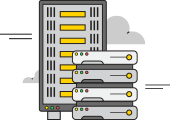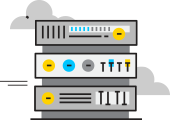Introduction
In the world of cyber threats, Distributed Denial of Service (DDoS) attacks continue to be a major concern for businesses and organizations. Among the various DDoS attack techniques, the NTP Amplification Attack stands out as one of the most potent and damaging methods used by malicious actors to disrupt online services. This article aims to provide an in-depth understanding of the NTP Amplification Attack, exploring its history, inner workings, types, solutions, and its potential association with proxy servers.
History of the Origin of NTP Amplification Attack
The NTP Amplification Attack, also known as the NTP reflection attack, was first identified in 2013. It exploits a vulnerability in the Network Time Protocol (NTP) servers, which are essential for synchronizing time on computers and network devices. The attack takes advantage of the monlist command, a feature designed to retrieve information about recent clients, to amplify attack traffic to a target. The significant amplification factor, combined with the ability to spoof the source IP address, makes this attack particularly dangerous and challenging to mitigate.
Detailed Information about NTP Amplification Attack
The NTP Amplification Attack relies on a technique known as reflection, where attackers send a small request to a vulnerable NTP server, spoofing the source IP address as the target’s IP. The NTP server then responds to the target with a much larger response than the original request, causing a flood of traffic to overwhelm the target’s resources. This amplification effect can reach up to 1,000 times the size of the initial request, making it a highly effective DDoS attack vector.
The Internal Structure of the NTP Amplification Attack
The NTP Amplification Attack involves three key components:
-
Attacker: The individual or group launching the attack, who utilizes various techniques to send a small request to the vulnerable NTP servers.
-
Vulnerable NTP Servers: These are publicly accessible NTP servers with the monlist command enabled, making them susceptible to the attack.
-
Target: The victim of the attack, whose IP address is spoofed in the request, causing the amplified response to flood their resources and disrupt their services.
Analysis of Key Features of NTP Amplification Attack
To better understand the NTP Amplification Attack, let’s analyze its key features:
-
Amplification Factor: The ratio between the size of the response generated by the NTP server and the size of the initial request. The higher the amplification factor, the more potent the attack.
-
Source IP Spoofing: Attackers falsify the source IP address in their requests, making it challenging to trace the origin of the attack and enabling a greater level of anonymity.
-
Traffic Flooding: The attack floods the target with a massive volume of amplified traffic, consuming its bandwidth and overwhelming its resources.
Types of NTP Amplification Attacks
NTP Amplification Attacks can be classified based on the specific techniques used or their intensity. Here are some common types:
| Attack Type | Description |
|---|---|
| Direct NTP Attack | Attackers directly target a vulnerable NTP server. |
| Reflective Attack | Attackers use multiple intermediate NTP servers to reflect and amplify the attack traffic towards the target. |
Ways to Use NTP Amplification Attack, Problems, and Solutions
The NTP Amplification Attack poses significant challenges for network administrators and cybersecurity experts. Some of the key issues and solutions include:
-
Problem: Vulnerable NTP Servers – Many NTP servers are configured with outdated settings, allowing the monlist command to be exploited.
Solution: Server Hardening – Network administrators should disable the monlist command and implement access controls to prevent unauthorized NTP queries.
-
Problem: IP Spoofing – Source IP spoofing makes it difficult to trace the attackers and hold them accountable.
Solution: Network Filtering – Network ingress filtering can be employed to drop incoming packets with spoofed source IP addresses, reducing the impact of reflection attacks.
-
Problem: Attack Mitigation – Detecting and mitigating NTP Amplification Attacks in real-time is crucial for ensuring service availability.
Solution: DDoS Protection Services – Utilizing specialized DDoS protection services can help detect and mitigate NTP Amplification Attacks effectively.
Main Characteristics and Comparisons with Similar Terms
| Term | Description |
|---|---|
| NTP Amplification | Exploits monlist command for DDoS reflection attacks. |
| DNS Amplification | Exploits DNS servers for DDoS reflection attacks. |
| SNMP Amplification | Exploits SNMP servers for DDoS reflection attacks. |
| UDP Flood Attack | Overwhelms target with high volumes of UDP traffic. |
| TCP SYN Flood Attack | Overwhelms target with SYN requests in a TCP handshake. |
Perspectives and Future Technologies Related to NTP Amplification Attack
As technology evolves, so do cyber threats. While solutions for mitigating NTP Amplification Attacks continue to improve, attackers are likely to adapt and find new attack vectors. It is essential for cybersecurity professionals to stay updated with the latest trends and develop innovative technologies for safeguarding against emerging threats.
Proxy Servers and NTP Amplification Attack
Proxy servers can play a crucial role in mitigating NTP Amplification Attacks. By acting as an intermediary between clients and NTP servers, proxy servers can filter and inspect incoming NTP requests, blocking potential malicious traffic before it reaches the vulnerable NTP servers. This can help reduce the risk of amplification attacks and improve overall network security.
Related Links
For more information about NTP Amplification Attacks and DDoS protection, you can refer to the following resources:
- US-CERT Alert (TA14-013A) – NTP Amplification Attacks
- IETF – Network Time Protocol Version 4: Protocol and Algorithms Specification
- Cloudflare – NTP Amplification Attacks
- OneProxy – DDoS Protection Services (Link to the DDoS protection services offered by OneProxy)
Conclusion
The NTP Amplification Attack remains a significant threat in the realm of DDoS attacks due to its high amplification factor and source IP spoofing capabilities. Understanding its inner workings and employing robust mitigation strategies are critical for ensuring the resilience of online services. As technology progresses, staying vigilant against emerging threats and leveraging technologies like proxy servers for protection becomes indispensable in the fight against NTP Amplification Attacks.




